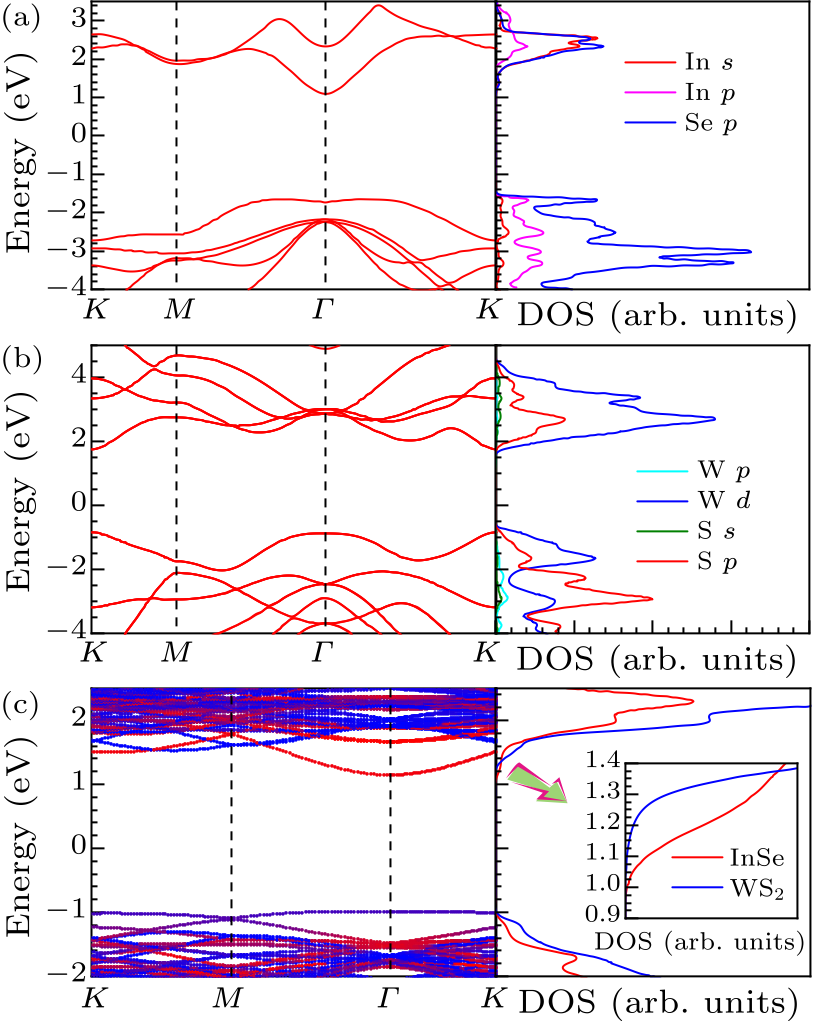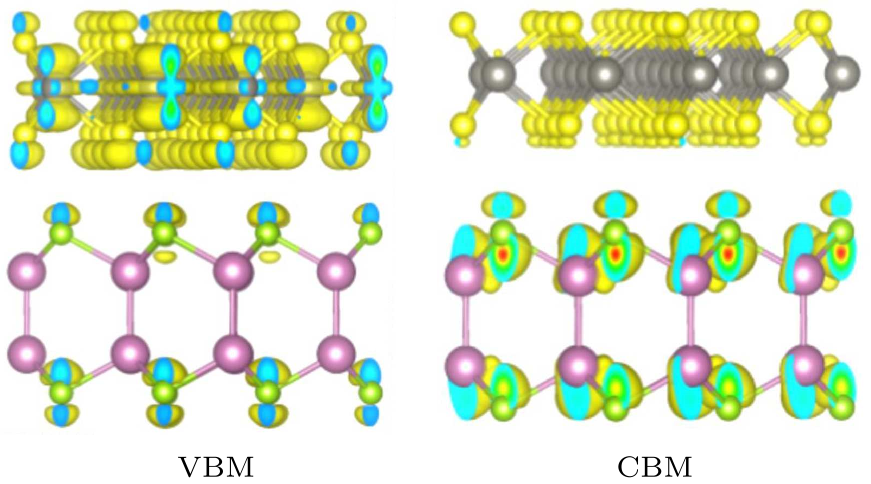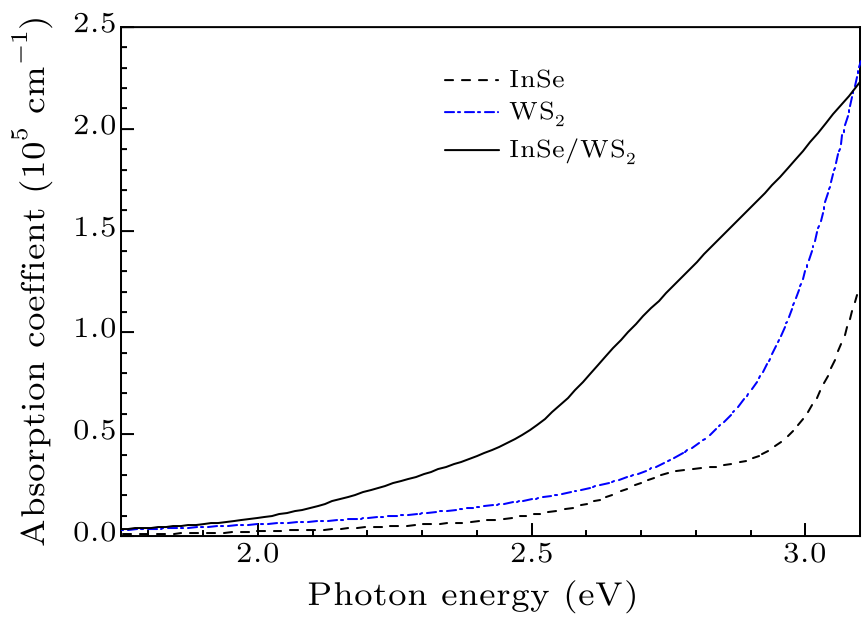
Fig. 1. The top and side views of the crystal structures.[33] (a) Monolayer InSe has a honeycomb lattice connected by Se–In–In–Se sequence. (b) Monolayer WS$_2$ also has a hexagonal configuration, with each W atom anchored by three pairs of S atoms by S–W–S sequence. One of the lattice vectors (thick solid-black arrows) of the InSe (WS$_2$) supercell makes an angle of 30$^{\circ}$ (23.4$^{\circ}$) to the horizontal lattice vector (parallel to the thin dashed-black line) of its primitive cell. (c) One (optimized) primitive cell of the 2D InSe/WS$_2$ heterostructure is composed of the supercells of the InSe and WS$_2$ monolayers shown in (a) and (b). One monolayer is stacked on the other by matching the rhombuses of their supercells until they coincide with each other. The optimized interlayer distance is $d=3.40$ Å in the heterostructure.
| MLs | $a$ | $E_{\rm g}$ (PBE) | $E_{\rm g}$ (GGA-1/2) | $E_{\rm g}$ (GW) | $E_{\rm g}$ (Exp.) |
|---|---|---|---|---|---|
| InSe | 4.09 | 1.47 | 2.75 | 2.83$^{\rm a}$ | 2.6$^{\rm c}$ |
| WS$_2$ | 3.19 | 1.77 | 2.59 | 2.64$^{\rm b}$ | 2.38$^{\rm d}$ |
|
$^{\rm a}$From Ref. | |||||

Fig. 2. Band structures and projected DOS. (a) Monolayer InSe has an indirect bandgap (2.75 eV) with the CBM located at ${\it \Gamma}$ point and the VBM located between ${\it \Gamma}$ and $K$ points. Its CBM (VBM) is mainly composed of Se 4$p$ and In 5$s$ (5$p$) orbitals. (b) Monolayer WS$_2$ has a direct bandgap of 2.59 eV with both its CBM and VBM located at $K$ points.[35] Its W 5$d$ orbitals play the dominant role in both the CBM and VBM, while its S 3$p$ orbitals make a minor contribution. (c) The weighted band structure and DOS of the InSe/WS$_2$ heterostructure. Its CBM is dominated by the InSe layer as shown by the inset.

Fig. 3. The charge density at the VBM (CBM) depicted by the isosurface ($\rho=1.36\times10^{-4}\,e$Å$^{-3}$) in the heterostructure.

Fig. 4. Absorption spectra of visible light. The solid-black, dash-dotted-blue, and dashed-black curves depict the variation of the absorption coefficients with photon energy for the InSe/WS$_2$ heterostructure, monolayer WS$_2$, and monolayer InSe, respectively.
| Carriers | Materials | $m_x^{\ast}$ | $m_y^{\ast}$ | $E_{1x}$ | $E_{1y}$ | $C_{{\rm 2D}-x}$ | $C_{{\rm 2D}-y}$ | $\mu_{{\rm 2D}-x}$ | $\mu_{{\rm 2D}-y}$ |
|---|---|---|---|---|---|---|---|---|---|
| InSe | 0.18 | 0.19 | $-$4.42 | $-$4.32 | 49.47 | 48.70 | 1667 | 1584 | |
| Electrons | WS$_{2}$ | 0.45 | 0.33 | $-$11.20 | $-$11.80 | 145.79 | 148.51 | 122 | 179 |
| InSe/WS$_{2}$ | 0.23 | 0.24 | $-$4.00 | $-$4.10 | 182.53 | 185.21 | 4503 | 4168 | |
| InSe | 1.84 | 2.01 | $-$1.40 | $-$1.37 | 49.47 | 48.70 | 152 | 143 | |
| Holes | WS$_{2}$ | 0.53 | 0.43 | $-$5.19 | $-$5.40 | 145.79 | 148.51 | 456 | 529 |
| InSe/WS$_{2}$ | 1.22 | 1.15 | $-$3.48 | $-$4.23 | 182.53 | 185.21 | 223 | 162 |
| [1] | Wang Q H et al 2012 Nat. Nanotechnol. 7 699 | Electronics and optoelectronics of two-dimensional transition metal dichalcogenides
| [2] | Chhowalla M et al 2013 Nat. Chem. 5 263 | The chemistry of two-dimensional layered transition metal dichalcogenide nanosheets
| [3] | Xu K et al 2016 Nanoscale 8 16802 | Synthesis, properties and applications of 2D layered M III X VI (M = Ga, In; X = S, Se, Te) materials
| [4] | Huang W et al 2016 CrystEngComm 18 3968 | 2D layered group IIIA metal chalcogenides: synthesis, properties and applications in electronics and optoelectronics
| [5] | Xu M, Liang T, Shi M and Chen H 2013 Chem. Rev. 113 3766 | Graphene-Like Two-Dimensional Materials
| [6] | Feng W, Zheng W, Cao W and Hu P 2014 Adv. Mater. 26 6587 | Back Gated Multilayer InSe Transistors with Enhanced Carrier Mobilities via the Suppression of Carrier Scattering from a Dielectric Interface
| [7] | Bandurin D A et al 2017 Nat. Nanotechnol. 12 223 | High electron mobility, quantum Hall effect and anomalous optical response in atomically thin InSe
| [8] | Mudd G W et al 2013 Adv. Mater. 25 5714 | Tuning the Bandgap of Exfoliated InSe Nanosheets by Quantum Confinement
| [9] | Zhuang H L and Hennig R G 2013 Chem. Mater. 25 3232 | Single-Layer Group-III Monochalcogenide Photocatalysts for Water Splitting
| [10] | Hu T, Zhou J and Dong J 2017 Phys. Chem. Chem. Phys. 19 21722 | Strain induced new phase and indirect–direct band gap transition of monolayer InSe
| [11] | Ding Y M et al 2017 Nanoscale 9 14682 | Enhancement of hole mobility in InSe monolayer via an InSe and black phosphorus heterostructure
| [12] | Yan F et al 2017 Nanotechnology 28 27LT01 | Fast, multicolor photodetection with graphene-contacted p -GaSe/ n -InSe van der Waals heterostructures
| [13] | Wu Z B et al 2018 Chin. Phys. B 27 077302 | Electronic properties of silicene in BN/silicene van der Waals heterostructures
| [14] | He Y et al 2019 J. Phys. D 52 015304 | Two-dimensional g-C 3 N 4 /InSe heterostructure as a novel visible-light photocatalyst for overall water splitting: a first-principles study
| [15] | He X et al 2016 Appl. Phys. Lett. 109 173105 | Strain engineering in monolayer WS 2 , MoS 2 , and the WS 2 /MoS 2 heterostructure
| [16] | Ju L et al 2018 Appl. Surf. Sci. 434 365 | DFT investigation on two-dimensional GeS/WS2 van der Waals heterostructure for direct Z-scheme photocatalytic overall water splitting
| [17] | Kumar R, Das D and Singh A K 2018 J. Catal. 359 143 | C2N/WS2 van der Waals type-II heterostructure as a promising water splitting photocatalyst
| [18] | Wang G et al 2018 J. Phys. D 51 025109 | Hybrid density functional study on the photocatalytic properties of AlN/MoSe 2 , AlN/WS 2 , and AlN/WSe 2 heterostructures
| [19] | Coleman J N et al 2011 Science 331 568 | Two-Dimensional Nanosheets Produced by Liquid Exfoliation of Layered Materials
| [20] | PereaL ópez N et al 2013 Adv. Funct. Mater. 23 5511 | Photosensor Device Based on Few-Layered WS 2 Films
| [21] | Zhuang H L and Hennig R G 2013 J. Phys. Chem. C 117 20440 | Computational Search for Single-Layer Transition-Metal Dichalcogenide Photocatalysts
| [22] | Ovchinnikov D et al 2014 ACS Nano 8 8174 | Electrical Transport Properties of Single-Layer WS 2
| [23] | Yang Y et al 2015 Adv. Funct. Mater. 25 6199 | Vertically Aligned WS 2 Nanosheets for Water Splitting
| [24] | Pesci F M et al 2017 ACS Catal. 7 4990 | MoS 2 /WS 2 Heterojunction for Photoelectrochemical Water Oxidation
| [25] | Kresse G and Furthmüller J 1996 Phys. Rev. B 54 11169 | Efficient iterative schemes for ab initio total-energy calculations using a plane-wave basis set
| [26] | Perdew J P, Burke K and Ernzerhof M 1996 Phys. Rev. Lett. 77 3865 | Generalized Gradient Approximation Made Simple
| [27] | Kresse G and Joubert D 1999 Phys. Rev. B 59 1758 | From ultrasoft pseudopotentials to the projector augmented-wave method
| [28] | Ferreira L G, Marques M and Teles L K 2008 Phys. Rev. B 78 125116 | Approximation to density functional theory for the calculation of band gaps of semiconductors
| [29] | Klimeš J, Bowler D R and Michaelides A 2011 Phys. Rev. B 83 195131 | Van der Waals density functionals applied to solids
| [30] | Toroker M C et al 2011 Phys. Chem. Chem. Phys. 13 16644 | First principles scheme to evaluate band edge positions in potential transition metal oxide photocatalysts and photoelectrodes
| [31] | Saha S, Sinha T P and Mookerjee A 2000 Phys. Rev. B 62 8828 | Electronic structure, chemical bonding, and optical properties of paraelectric
| [32] | Qiao J et al 2014 Nat. Commun. 5 4475 | High-mobility transport anisotropy and linear dichroism in few-layer black phosphorus
| [33] | Momma K and Izumi F 2011 J. Appl. Crystallogr. 44 1272 | VESTA 3 for three-dimensional visualization of crystal, volumetric and morphology data
| [34] | Rigosi A F et al 2016 Phys. Rev. B 94 075440 | Electronic band gaps and exciton binding energies in monolayer transition metal dichalcogenide alloys probed by scanning tunneling and optical spectroscopy
| [35] | Yun W S et al 2012 Phys. Rev. B 85 033305 | Thickness and strain effects on electronic structures of transition metal dichalcogenides: 2H- semiconductors ( Mo, W; S, Se, Te)
| [36] | Kang J et al 2013 Appl. Phys. Lett. 102 012111 | Band offsets and heterostructures of two-dimensional semiconductors
| [37] | Amin B, Kaloni T P and Schwingenschlögl U 2014 RSC Adv. 4 34561 | Strain engineering of WS 2 , WSe 2 , and WTe 2
| [38] | Zeng F, Zhang W B and Tang B Y 2015 Chin. Phys. B 24 097103 | Electronic structures and elastic properties of monolayer and bilayer transition metal dichalcogenides MX 2 ( M = Mo, W; X = O, S, Se, Te): A comparative first-principles study
| [39] | Debbichi L, Eriksson O and Lebègue S 2015 J. Phys. Chem. Lett. 6 3098 | Two-Dimensional Indium Selenides Compounds: An Ab Initio Study
| [40] | Peng Q et al 2017 Catal. Sci. Technol. 7 2744 | Computational mining of photocatalysts for water splitting hydrogen production: two-dimensional InSe-family monolayers
| [41] | Jiang Z et al 2017 Phys. Rev. Lett. 118 266401 | Scaling Universality between Band Gap and Exciton Binding Energy of Two-Dimensional Semiconductors
| [42] | Kang P et al 2017 2D Mater. 4 045014 |
| [43] | Qiao J et al 2018 Sci. Bull. 63 159 | Few-layer Tellurium: one-dimensional-like layered elementary semiconductor with striking physical properties